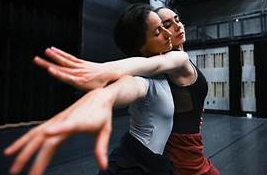At the dance organization Queer the Ballet, LGBTQ performers challenge the expectations of traditional ballet while creating work all their own.
Adriana Pierce, founder and artistic director of Queer the Ballet, recalls a time in her youth when she felt forced to live with two separate identities: one as a dancer in the studio and another as a queer woman outside of it. The rigid boundaries of ballet left little room for her to express both sides of herself. “I regret how I felt in ballet spaces during that time, because I had to leave so much of the best parts of me outside. I don’t think ballet got the best parts of me, and that’s a shame,” she shared.
This internal conflict is something many LGBTQ dancers have experienced in a field known for its strict gender roles and traditional expectations. Ballet has long been a space where femininity is narrowly defined, often making it difficult for LGBTQ individuals, especially queer women, transgender, and nonbinary dancers, to feel included. The lack of representation is so severe that it has led many LGBTQ performers to hide parts of their identities in order to fit in or advance in their careers.
Queer the Ballet, the organization Pierce founded, aims to change this. The group challenges the limitations of traditional ballet by creating inclusive spaces where LGBTQ dancers can openly express their identities. Their newest production, Dream of a Common Language, exemplifies this mission. The ballet is inspired by the 1970s poetry of lesbian writer Adrienne Rich, with themes of community and self-discovery.
As Pierce spoke about her experiences and the organization’s work, a group of queer dancers rehearsed next door. They were preparing for the debut of Dream of a Common Language, which opens on Friday. The performance is not only a celebration of Rich’s poetic exploration of identity and connection but also a reflection of Pierce’s own desire to create a community where LGBTQ dancers can come together without fear of judgment.
Pierce’s initiative goes beyond performance; it’s about creating a space where queer women, transgender, and nonbinary dancers can come together to challenge ballet’s restrictive norms. While the ballet world has long been a bastion of tradition, Queer the Ballet pushes for a reimagined future where identity and self-expression are not only accepted but celebrated.
For Pierce, the creation of Queer the Ballet is deeply personal. Having faced the struggles of compartmentalizing her identity as a dancer and a queer woman, she is determined to provide a space for those who feel marginalized by the traditional ballet world. Through the organization, she envisions a world where LGBTQ dancers no longer have to hide parts of themselves but can instead thrive as their authentic selves.

